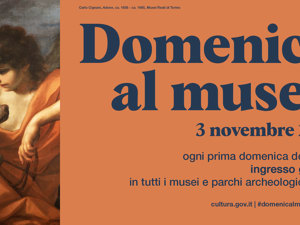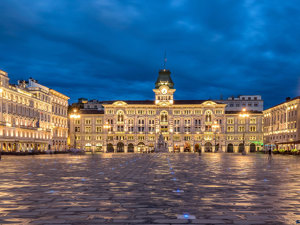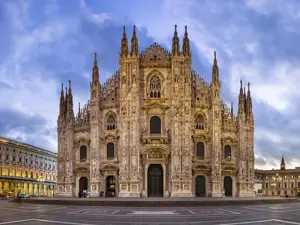The city with central European charm
Sitting at the foot of the Karst Plateau, and extending along the beautiful mouth of the gulf on the Adriatic Sea, Trieste captivates the visitor with its poetic and lively atmosphere, and with a great variety of styles left by the many populations who lived here.

Trieste. Editorial use only: Copyright © Sisterscom.com / Shutterstock
For several centuries the city belonged to the Habsburg Empire, an empire that left signs which are still visible today in the buildings, culture, atmosphere and even the cuisine.

The Port of Trieste. Trieste. Editorial use only: Copyright © Sisterscom.com / Shutterstock
The Port of Trieste
It was an opulent city in the eighteenth century due to intense maritime trade, the result of its status as a free port, which was granted in the same century by Charles IV of Habsburg. Trieste is still renowned today for its very well equipped Port, which is able to host yachts of large dimensions and cruise ships.

Church of San Giusto, Trieste. Editorial use only: Copyright © Sisterscom.com / Shutterstock
Church of San Giusto
The most famous and significant monument is the beautiful Romanesque Church of San Giusto, the city’s cathedral. This Catholic church stands on the hill of the same name, which was once the site of the old Roman “Tergeste” where a Paleo-Christian basilica was built over the remains of a temple dedicated to the Pagans. At the beginning of the first millennium, the basilica was replaced by two buildings: a cathedral dedicated to Our Lady of the Assumption and the Sacello di San Giusto, which in turn were transformed into one place of worship, the Cathedral of San Giusto, which has stupendous frescos that portray the life and passion of the Saint.
The churches in Jewish quarter of Trieste
However, even in the places of worship of the different religions a cosmopolitanism is perceived: the Eastern Greek Church of San Niccolò, the Serbian Orthodox Church of San Spiridione, the Evangelist-Methodist Church and the Jewish synagogue, built as a result of the Edict of Tolerance issued in the mid eighteenth century by Marie Therese of Austria. The Jewish quarter is significant: the Jewish community, in fact, present in Trieste since the fifteenth century, but banished to the ghetto at the end of the seventeenth century, was able to freely integrate in social and trading activities thanks to the edict of the Emperor. Today the old ghetto is a striking district in which symbolic names remain, such as the Via del Pane (Bread Street), Via delle Beccherie (Slaughterhouse Street), Via delle Ombrelle (Umbrella Street), and where there are many second-hand shops.
Piazza Unità d’Italia in Trieste

Piazza Unità d’Italia,Trieste. Editorial use only: Copyright © Sisterscom.com / Shutterstock
Piazza Unità d’Italia is the beating heart of the city. It has a wonderful romantic and timeless atmosphere that has remained unspoilt for decades, which takes us back to a time of elegant cafes frequented by an intellectual elite, such as Italo Svevo, Umberto Saba and even James Joyce. These historic cafes, such as the Tommaseo, the Tergesteo and the Caffè degli Specchi, still with their newspapers on handy wooden rods, have remained untouched. The nineteenth-century atmosphere is also found in other historic places such as the old patisserie Pirona, the patisserie Bomboniera and the Libreria Antiquaria (Antique Bookshop), which was owned by Umberto Saba.
Palaces and Castles of Trieste

Castle of Miramare, Trieste. Editorial use only: Copyright © Sisterscom.com / Shutterstock
Palaces and castles are also witness to the opulence of the Trieste aristocracy of the seventeenth century, and the upper classes of the nineteenth century: Palazzo Rivoltella, Palazzo Morpurgo, Villa Sartorio. The castle that must be visited is the sumptuous Castello di Miramare, overlooking the Gulf of Trieste, which was commissioned by the Archduke Maximilian of Habsburg as a home for himself and his beloved wife Charlotte of Belgium. The building is a major city attraction and one of the most visited in Italy, not just for its architectural beauty and the vast garden filled with rare examples of plants, but also for the unhappy story of its old owner who was shot in Mexico.
From the coast to the Karst mountains, the area offers a variety of scenery, some unique such as the white limestone rocks that conceal an underground world abundant with caves, including the celebrated Grotta Gigante (Giant Cave), which is so large it could contain St. Peter’s Basilica of Rome.

Chocolaty Sacher. Trieste. Editorial use only: Copyright © Sisterscom.com / Shutterstock
The tipical dishes
The cuisine is influenced by the variety of the people who inhabited Trieste and its unique position between the mountains and the sea: dishes of fish are served alongside flavoursome, spicy meat dishes, including pork or ham cooked or in a crust and sausages with cabbage.
It is above all the sweets in the numerous windows of cafes and patisseries that are the most tempting, sweets that are mostly of Austrian origin, such asputizza, a ring-shaped cake filled with chocolate and nuts, presnitz (puff pastry filled with walnuts, raisins and pine nuts) and the delicious and very chocolaty Sacher, as well as quince jam, marzipan and pink nougat.
Text by Anna Glik
Update by Alisè Vitri
Video: www.turismofvg.it
Tourism Board
www.retecivica.trieste.it - www.turismofvg.it
Partnership with Booking.com
Where to sleep in Trieste

Trieste. Editorial use only: Copyright © Sisterscom.com / Shutterstock
Trieste is a welcoming city and offers different possibilities for accommodation.
To find the ideal hotel and the best offers you can do a search for the stars but also for districts or landmarks.
LANDMARKS
where to go in trieste
Monuments and Museums of Trieste

Editorial use only: Copyright © Sisterscom.com / Shutterstock
SAN GIUSTO'S CATHEDRAL
Piazza della Cattedrale, 2
San Giusto’s Cathedral, located on the hill of the ancient roman Tergeste, is the main religious building of the city. The facade of the San Giusto church is shaped like a hut enriched with an elegant Gothic rose window built in Kras stone. The massive bell tower is a defence tower dates back to the XIV century. Inside, in the right aisle, is possible to admire the majestic mosaic of the San Giusto’s sacellum apse, dating back to the 1200s, where a image of Christ dominates in a gold background. The cathedral also houses the Chapel of the Treasury.
San Giusto’s Cathedral, located on the hill of the ancient roman Tergeste, is the main religious building of the city. The facade of the San Giusto church is shaped like a hut enriched with an elegant Gothic rose window built in Kras stone. The massive bell tower is a defence tower dates back to the XIV century. Inside, in the right aisle, is possible to admire the majestic mosaic of the San Giusto’s sacellum apse, dating back to the 1200s, where a image of Christ dominates in a gold background. The cathedral also houses the Chapel of the Treasury.

Editorial use only: Copyright © Sisterscom.com / Shutterstock
UNITY SQUARE AND AUDACE PIER
Unity Square was called in ancient time St. Peter’s Square then Piazza Grande (Great Square) and renamed Piazza Unità (Unity Square) after 1918, when the city was annexed to the Kingdom of Italy. The square is paved with recent sandstone slabs, 8 cm thick. The Audace Pier, originally called St. Charles, is not bordered by limestone, like the banks, but it has only paving stones (masegno). From the pier you can see a panoramic view of the city of Trieste and its surroundings.

Editorial use only: Copyright © Sisterscom.com / Shutterstock
MIRAMARE CASTLE
Parco di Miramare - Viale Miramare
The Miramare Castle, built by the Archduke Ferdinand Maximilian of Hapsburg in the second half of the 19th century, is a luxurious noble house preserved with its original furnishings. The Castle is surrounded by a flourishing park, with a surface of 22 hectares, full of botanic species and enjoys a fantastic panoramic location, overlooking the sea, on the peak of the rocky promontory of Grignano.
The Miramare Castle, built by the Archduke Ferdinand Maximilian of Hapsburg in the second half of the 19th century, is a luxurious noble house preserved with its original furnishings. The Castle is surrounded by a flourishing park, with a surface of 22 hectares, full of botanic species and enjoys a fantastic panoramic location, overlooking the sea, on the peak of the rocky promontory of Grignano.

Editorial use only: Copyright © Sisterscom.com / Shutterstock
REVOLTELLA MUSEUM OF MODERN ART GALLERY
Via Diaz, 27
The Revoltella Museum is a modern art gallery located in the center of Trieste, a short distance from the seashore. The Gallery was founded in 1872 by Baron Pasquale Revoltella (1795-1869), one of the most representative figures of the Trieste-based company nineteenth century, who decided to leave the city his home and all the works of art, furnishings and books.
The Revoltella Museum is a modern art gallery located in the center of Trieste, a short distance from the seashore. The Gallery was founded in 1872 by Baron Pasquale Revoltella (1795-1869), one of the most representative figures of the Trieste-based company nineteenth century, who decided to leave the city his home and all the works of art, furnishings and books.
CIVIC HISTORY AND ART MUSEUM
Piazza della Cattedrale, 1
The 18th century Museum of History and Art of Trieste features a collection of tombstones and the finding of local history from prehistory to late antiquity. The museum's collection was formed around the monument of J.J.Winckelmann, considered the father of archeology, murdered in Trieste in 1768. The museum also contains collections from Egypt, Cyprus, Greece and the colonies of Magna Graecia, from Etruria and even a small collection of Mayan ceramics from El Salvador.
MUSEUM SARTORIO
Largo Papa Giovanni XXIII, 1
The Civic Museum Sartorio, is housed in an elegant villa of the nineteenth located a short distance from the sea and surrounded by a large garden. In 1947 it became a "house museum", thanks to the will of Anna Segre Sartorio. Inside you will find furniture, artworks and objects in different styles: Empire and Biedermeier historical revival, neo-rococo and neo-gothic.
The Civic Museum Sartorio, is housed in an elegant villa of the nineteenth located a short distance from the sea and surrounded by a large garden. In 1947 it became a "house museum", thanks to the will of Anna Segre Sartorio. Inside you will find furniture, artworks and objects in different styles: Empire and Biedermeier historical revival, neo-rococo and neo-gothic.
Excursions

Editorial use only: Copyright © Sisterscom.com / Shutterstock
AQULEIA
Aquileia, a few kilometers from Trieste, is one of the most important archaeological sites in Northern Italy. The city, was founded as a colony by the Romans in 181 BC. and most interesting is the patriarchal Basilica di Santa Maria Assunta. Do not miss to visit the Forum of the 2nd century A.D., once the main square in the city, as well the burial ground, the only example of a Roman cemetery discovered in Aquileia.

Editorial use only: Copyright © Sisterscom.com / Shutterstock
LUBIANA AND BLED ISLAND
From Trieste you reach the capital of Slovenia, Ljubljana, to discover its history and explore the ancient and modern architecture of the medieval old town. To be seen, the Cathedral, the Baroque fountain of Robba, the buildings of the Preseren Square, the monuments of the architect Jože Plečnik, the bridges, the squares and the parks. Then you reach Bled Island to admire the Gothic Church dedicated to the Assumption of Mary and Bled Castle, built on a precipice on the lake.
Partnership with GetYourGuide
All tours and excursions
News & Useful info
Shopping
You might be interested in
Destinations found in the vicinity
Other destinations
Airports nearby Trieste































